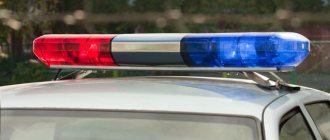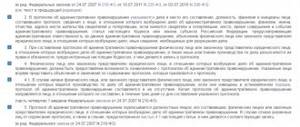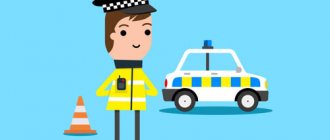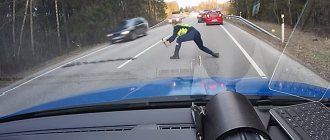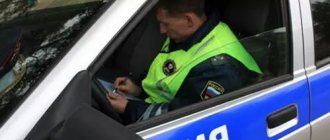Why is it needed?
So, any punishment is imposed on the driver only after a certain review procedure. This procedure is called an administrative case. In general cases, it can be considered by police officers or judges (less often, prosecutors and other officials).
The protocol is needed in order to initiate such an administrative case. Essentially, without this paper (the protocol for 2021 is only possible in written form, but not electronic), there is no business itself. But there are exceptions.
Article 28.2 of the Code of Administrative Offences. 1. A protocol is drawn up on the commission of an administrative offense, except for the cases provided for in Article 28.4, parts 1, 3 and 4 of Article 28.6 of this Code.
When is it compiled?
A protocol is drawn up immediately after the inspector discovers a violation.
The reasons for logging include the following:
- making a decision (resolution) on an offense is not within the competence of the inspectorate employee;
- the offense was committed by an official and does not provide for a warning;
- the driver was a person under the age of majority;
- the violator is an active military serviceman;
- the offender refuses to admit the guilt of the incident, including to sign the resolution in the case of an administrative offense.
How is it different from a resolution?
The traffic police protocol differs from the resolution, and the difference is cardinal, although they both relate to the fact that the driver violated traffic rules.
If the protocol, as we said above, initiates a case of violation, then the resolution actually ends the consideration of this case. That is, a resolution is a kind of verdict and outcome of the procedure for clarifying the circumstances and determining the driver’s guilt with the imposition of a fine (or other type of punishment) as the result of this case.
In principle, many of the rules listed below apply to both the protocol and the resolution. After all, the latter also has a column for the comments of the person involved, where you need to write the necessary information (see below), if he does not agree with the violation of traffic rules, it also needs to be signed, and refusal to sign can result in similar consequences.
Only the samples of the traffic police protocol and resolution are different.
Is it possible to appeal the protocol?
No. There is logically nothing to appeal against in the protocol, since the protocol only initiates the case. That is, a protocol is a document indicating all the circumstances of the case for their subsequent consideration (perhaps even by another inspector or judge, prosecutor, etc.), and the case is conducted on the basis of a resolution. And there's nothing to complain about.
Only the decision is appealed.
You will also be interested in:
- Is it possible to refuse to sign the protocol and resolution and what will be the penalty for this?
- How to appeal (challenge) a traffic police fine?
- Suspension from driving a vehicle in questions and answers
What is the basis for issuing a fine?
The fine is issued on the basis of a resolution, not a protocol. The protocol drawn up on the road goes to the authorities, they review it and make this very decision on it.
If you are sure that there was no violation on your part, you will have to appear at the hearing of your case, otherwise you will still be fined, even if the protocol says that you do not agree with the violation.
Alas, in practice, the attitude towards this part of the process is very negligent both on the part of the authorities and the “fined” themselves, who either forgot about it or did not find the time to appear on the specified day and hour, and the police once again are in no hurry to remind them of this . As a result, the decision is stamped without your participation, a copy is sent to you by mail, and from that moment on you begin to be fined.
When is it not carried out?
In fact, there is only one such exception - the absence of the fact that the person involved challenges the punishment. Then a decision is immediately issued - this is a document that already establishes the driver’s guilt, and he is assigned an administrative fine or other punishment (Part 1 of Article 28.6 of the Administrative Code).
A decision without a protocol can be made only in cases where the article of the code provides only for either a fine or a warning.
When must a traffic police report be drawn up?
From the above, it is logical that if you do not agree with the violation of traffic rules, then a protocol must be drawn up against you (part 2 of article 28.6 of the Code of Administrative Offenses and clause 142 of the Administrative Regulations). At the same time, it can be written later - after the decision is made.
This is a legislative absurdity when a protocol, which in essence only initiates a case, is written after the punishment in this case has been assigned by the corresponding resolution.
Sample traffic police report 2021
The legislation of 2021 regulates only the procedure for filling out the protocol regarding the mandatory data that must be indicated in it. There is no sample protocol in the established form. But there is a recommended sample, which is prescribed in the Administrative Regulations of Order No. 664 of the Ministry of Internal Affairs.
The protocol is filled out on both sides and has one sheet.
Sample of the front side of the protocol:
Reverse side of the protocol:
.
What are the rules for writing out?
The procedure for drawing up a protocol is regulated by Article 28.2 of the Code of Administrative Offenses and neighboring articles. Thus, the protocol must contain certain information about the place and date of the traffic violation, about the inspector and the driver.
In particular, the required data for the protocol (Part 2 of Article 28.2 of the Administrative Code):
- date and place of writing the protocol on the APN,
- Full name and position of the traffic police inspector who issues it
- Full name, registration address, place of work of the hired driver,
- Full name, registration addresses of witnesses and/or victims due to the driver’s fault,
- date and time of traffic violation, as well as a description of the violation event itself,
- any other data somehow related to the consideration of the APN.
The protocol also provides space for explanations from the person involved, those affected by the violation and witnesses.
It is imperative that when a traffic police officer writes a protocol in our situation, he is obliged to explain the rights of the person involved, in particular, Article 25.1 (the right to familiarize himself with the documents in the case), as well as Article 51 of the Constitution of the Russian Federation (the right not to testify against oneself or one’s close relatives) - this is prescribed part 3 of article 28.2 of the Code of Administrative Offenses, as well as paragraph 150 of the regulations.
Next, the original protocol remains with the inspector, and the driver is given a copy of it, and is also asked to sign it.
Should the inspector write out a protocol in front of me?
No. The inspector does not have such a direct responsibility. Both the protocol and the resolution can be written separately from the driver. But an important point: the driver (the person against whom the case has been initiated) must be presented with a protocol for review by the traffic police officer, and also asked to sign and write comments in this document. The duty of the traffic police inspector to do this is stated in paragraph 151 of the regulations.
What if you don't sign?
As we have already said, it is the inspector’s responsibility to hand over the traffic police report for the driver’s signature. Can he force a subscription if the latter refuses to do so? No.
But your refusal to sign the protocol may mean absolutely nothing. Moreover, usually those who refuse it, taking an aloof position, do not even look at it and do not read what the inspector wrote there. And he could write a lot.
That is why, instead of refusing to sign the protocol, we recommend, on the contrary, that you study it carefully, and also write in the explanation column your violated rights and directly indicate your disagreement with the violation.
It is a common practice that a copy of the protocol is not offered to the driver for signature at all. In this case, the traffic police officer, taking advantage of the driver’s ignorance of the law, simply does not even offer him a protocol to sign. Instead, in the column for this he writes “Refused to sign.” Part 5 of Article 28.2 of the Code of Administrative Offenses gives the inspector this right.
That is why we advise you to videotape the process of conducting a case against you.
Something else useful for you:
- How to appeal a fine for not allowing a pedestrian to pass? Form, sample and instructions
- How to appeal a speed camera ticket? Complaint form, procedure, deadlines
- A fine for average speed - is it legal and how to appeal?
Can the inspector draw up a report not immediately?
Maybe, but only in exceptional cases. The right to write out a protocol is then given to him by clause 143 of the regulations of the Ministry of Internal Affairs. There can be only 2 reasons for writing a traffic police report not immediately in 2021:
- unknown information about the circumstances of the case at the moment,
- impossibility of finding out personal information about the person involved.
In both cases, the delay in prescribing should not exceed 2 days.
Needless to say, the listed reasons for deferment cannot, in principle, occur in standard violation schemes. For example, when a driver saw a traffic violation on the road, he stopped the driver to attract attention. In this case, the traffic police officer has all the data.
Consideration of the case in the traffic police
Having received a protocol at the place of communication with the traffic police inspector, the driver receives an invitation to consider the case in the traffic police or in court. It happens that the case is considered at the place of stop; in this case, the received decision should be appealed to the district court at the place where the documents were drawn up. However, we will talk about appealing a little later.Frankly speaking, the consideration of the case by the traffic police is nothing more than a simple fiction. Everything has already been decided and you should not hope for an objective consideration of your case. Regardless of what you say and what evidence you provide, in 99 cases out of 100 you will stupidly be given a guilty verdict. Or they will stupidly transfer your case to a magistrate. You can, of course, sprinkle ashes on your head, repent, and promise not to break it again. It happens that with this line of behavior it is possible to get off with minimal punishment. But rarely.
It is difficult to give unambiguous advice on the issue of whether or not to go to the consideration of a case at the traffic police. If the offense charged to you requires deprivation of the right to drive a car, then I would not go to the traffic police. With a 99% probability, the case will be sent to court, and you will lose several hours standing in line, only to listen to this unlawful verdict in 30 seconds. If a miracle happens and the traffic police decide that a fine is enough for your offense, then they will calmly issue a fine without you. If, a month after the scheduled consideration, an envelope with a subpoena from the court does not appear in your mailbox, then it does not hurt to stop by the traffic police and ask the administrative practice department about the fate of your case. And if you are punished with a fine, then you should ask for a copy of the decision, making sure to indicate the date it was received. And if the materials have been sent to court, then you can stop by the court or continue to wait for the summons.
If they cannot present you with anything other than a fine, then, despite the obviously known result, and if your plans include the subsequent cancellation of the decision, then it is better to come for consideration. The purpose of visiting the traffic police is not to terminate the proceedings due to your innocence (only the naive can hope for this), but to try to record all the procedural violations committed by the traffic police officers when considering the case.
It is very advisable to have a voice recorder, a defender, a couple of friends for moral support and several prepared petitions with you. The form for writing petitions is simple.
____________________________________ from Ivanov Ivan Ivanovich Ekaterinburg, Stalin street. eleven
Petition
Your introduction contains an administrative case against Ivan Ivanovich Ivanov .
(Following is the text of the petition)
date
Signature
If you don’t know whose name to write the petition in, then it’s better not to indicate in advance, because If the addressee is incorrectly specified, your application may not be accepted. For example, if you come for a review at the traffic police department of the Leninsky district of Yekaterinburg, then the application should be addressed to the Separate platoon of the traffic police , and not to the traffic police department of the Leninsky district police department .
The procedure for considering the case is regulated by Article 29.7 of the Code of Administrative Offenses of the Russian Federation, but the traffic police do not know the Code of Administrative Offenses, they do not comply with the required procedure, so I will not even introduce you to the contents of this article. I will only say that at the beginning of the consideration of the case, it is announced who is considering the case, what case is subject to consideration, who and on the basis of what law is brought to administrative responsibility. If this is not done, then I recommend that you definitely ask, at least, to introduce yourself to the traffic police officer who is considering the case. This is necessary so that you know exactly who you are dealing with and who you can then write complaints about. Otherwise, you can get into trouble.
For example, back in 2005, in the premises of the Separate Platoon of the State Traffic Safety Inspectorate of the Leninsky District, a case was being considered against the driver Bazuev N.A. A traffic police officer in the uniform of a senior lieutenant was sitting at the table, on the table there was a sign with the inscription “Commander of the Separate Platoon of the State Traffic Safety Inspectorate of the Leninsky District Internal Affairs Directorate of Yekaterinburg , senior police lieutenant Alexey Viktorovich Mamaev . The examination took place with gross procedural violations and the driver filed a complaint against the actions of this employee with the Yekaterinburg traffic police. Imagine his surprise when he was informed that on the date he indicated, the platoon commander could not consider his case, because... at that time I was on vacation and vacationing in distant Turkey.
Once the traffic police officer has been identified, you should begin filing petitions. I would start with the defender. The text will be as follows
According to Article 25.1 of the Code of Administrative Offenses of the Russian Federation, a person against whom proceedings are being conducted for an administrative offense has the right to use the legal assistance of a defense attorney.
In accordance with Article 25.5 of the Code of Administrative Offenses of the Russian Federation, in order to provide legal assistance to a person against whom proceedings for an administrative offense are being conducted, a defense attorney may participate in the proceedings for an administrative offense. A lawyer or other person is allowed to participate in proceedings regarding an administrative offense as a defense lawyer. The powers of the person providing legal assistance are certified by a power of attorney issued in accordance with the law.
Based on the above and in accordance with Article 24.4 of the Code of Administrative Offenses of the Russian Federation,
I ask
that Pyotr Petrovich Petrov be admitted to the trial as my defense lawyer (power of attorney attached)"
As follows from the text of the petition, any person can act as a defender, only a power of attorney must be issued for him. If you have a legally savvy friend, it is better to issue a power of attorney for him from a notary. The maximum validity period of a power of attorney is 3 years. It is optimal to always have it with you, along with your rights, and in case of conflict situations on the road with traffic police officers, call him as “your lawyer.” If you need a lawyer only for moral support, then the power of attorney can be certified at work. The text of the power of attorney may look like this.
POWER OF ATTORNEY
RUSSIAN FEDERATION, SVERDLOVSK region, EKATERINBURG city
THE SEVENTH OF SEPTEMBER TWO THOUSAND AND SIX
Citizen IVANOV IVANOVICH , born August 13, 1953, passport 65 02 111111, issued 04/27/2002. Kirovsky District Department of Internal Affairs of the city of Yekaterinburg, registered at the place of residence in Yekaterinburg on Stalina St., no. 1, apt. 1, and residing there,
I trust Petrov Petrovich , living at the address: Ekaterinburg, Stalina St., 1, apt. 2,
act as my DEFENDER and representative in judicial and other state and non-state bodies, organizations, before other citizens, with the rights provided for him by civil procedural and administrative legislation,
CONDUCT ALL CASES ON MY NAME, including administrative offenses, REPRESENT my interests in all the above-mentioned bodies, before legal entities and individuals, with all the rights granted by law to the person in respect of whom the proceedings for an administrative offense are being conducted, the plaintiff , the defendant, a third party, as well as the victim, including such as filing a complaint against a decision on an administrative offense (signing a complaint), filing a claim (signing a statement of claim), increasing or decreasing the amount of claims, changing the subject and basis of the claim, transfer cases to an arbitration court, complete or partial waiver of claims, conclusion of a settlement agreement, recognition of a claim, subrogation, appeal of a court decision (arbitration court act), filing (signing) an application with a request to file a protest, demanding the forced execution of a judicial act (presentation and revocation of a writ of execution), appealing against the actions of a bailiff, receiving awarded property or money.
The power of attorney was issued for a TERM of THREE years.
(full last name, first name and patronymic of the principal) (signature)
RUSSIAN FEDERATION, SVERDLOVSK region, EKATERINBURG city
On September seventh, two thousand and six, this power of attorney was CERTIFIED by me, SERGEY ANATOLIEVICH SAKHAROV, director of Horns and Hooves LLC (city of Yekaterinburg, Sverdlovsk region of the Russian Federation).
The power of attorney was SIGNED by IVAN IVANOVICH, working as an orderly at Horns and Hooves LLC, in my presence, the identity of the signatory was established, and his legal capacity was verified. The text of the power of attorney is read aloud to the signatory.
DIRECTOR (signature)
PRINTING PLACE
Petitions must be prepared in two copies - one is submitted to the traffic police officer considering the case, and on the second, ask for a mark of acceptance. The petition must be considered immediately and, if denied, a determination must be made. But I dare to assure you that the traffic police will not wait for a determination. At best, they will show you the verdict on your copy of the petition. And in the worst case, they will refuse verbally. But don’t be sad, you will keep the dictaphone recording (I hope you didn’t forget to turn on the dictaphone before entering the office) and you will always be able to record the fact of refusal in the future.
Now petition for your friends to come for moral support.
According to Article 24.3 of the Code of Administrative Offenses of the Russian Federation, cases of administrative offenses are subject to open consideration.
Based on the above and in accordance with Article 24.4 of the Code of Administrative Offenses of the Russian Federation
I beg
allow Sidor Sidorovich Sidorov and Mikhail Mikhailovich Mikhailov to be present during the consideration of the case.
Then you should familiarize yourself with the case materials.
According to Part 1 of Article 25.1 of the Code of Administrative Offenses of the Russian Federation, a person against whom proceedings are being conducted for an administrative offense has the right to familiarize himself with all the materials of the case.
Based on the above and in accordance with Article 24.4 of the Code of Administrative Offenses of the Russian Federation
I beg
permit familiarization with the case materials, making extracts and making photocopies.
You will probably be refused to make extracts and, especially, to take photographs of the case materials. Ask that the fact of refusal be recorded on your copy of the application. When reading, you should be most interested in the content of the reports of the traffic police officers who filed the offense and the scheme of the administrative offense. See if anything new has appeared on the diagram compared to what was shown to you at the stopping place. Just try to remember the contents of the reports.
Next, you can request the interrogation of witnesses, traffic police officers who drew up the protocol, and the addition of available evidence to the case materials (photos, an act of measuring the width of the road, etc.). But it's better not to do this. Because after hearing witnesses and introducing evidence, significant changes may occur in the case materials: reports will be rewritten and filled with new content, testimonies of new (fake) witnesses may appear, the APN diagram will be supplemented or drawn anew.
Therefore, I would calm down on this, listen to the verdict, receive a copy of the decision and go prepare to appeal.
Text provided by Badin Georgy Vilovich
What to write in the protocol if you do not agree with a traffic violation?
One of the basic rules for filling out a protocol by a driver, in which many drivers are mistaken, is that they harm themselves if they refuse to sign the document. As we said above, you don’t need to do this, but, on the contrary, carefully study it and sign it, as well as make the necessary notes, but which ones?
So, if you do not agree with the traffic violation charged to you, then you need to write the following in the protocol. It is important to write briefly and concisely. But, if your text does not fit in any columns, then write in these corresponding columns: “I gave the explanations on a separate sheet” and, of course, write what you want on a separate paper.
- In the field for explanations of the person involved, you need to write: “I do not agree with the violation. I need the help of a defender." Thus, you immediately report the fact of challenging a traffic violation. If you do not write this right away, then this, of course, will not deprive you of the right to appeal the decision with a fine, but the judge or other body considering the case will take into account that you did not agree with this initially. You can also briefly write a rationale for disagreeing with the violation.
- In the same column, if the traffic police officer did not explain your rights, you also need to make a note about this: “Rights not explained.”
- If there are witnesses or there is a video recording that can prove your innocence, write in the comments: “There is a video recording from the recorder.” or “There are witnesses [full name]. I request their involvement in the consideration of the administrative case.”
- If a traffic violation was committed (or not committed, but the traffic police officer blames it) in another city, and you want the case to be considered in your city, then write in the comments: “I am requesting that the case be considered at the place of residence.” The inspector must grant this request or provide compelling reasons for refusing to grant it. It is important to know that employees also respond to written requests in writing.
What should be included in the protocol
The protocol is an A4 format with a large amount of small text. It seems that it was created so unreadable on purpose. Not everyone has the patience to read what’s what, so for convenience, we made a sample, conditionally divided it into points that must be filled out, and give an explanation of what should be in it and how, and mark especially important points with the word “important” "
Not the entire protocol is filled out by the police, but most of it, we have highlighted it in blue. Yellow - fields where your participation and signature are required, green - where either witnesses or you must write due to their absence. Look at the sample and compare it with the explanations.
1. Date, time and place.
Important. This item must be completed to the minute. It is the exact time of drawing up the protocol that in some cases is very important. For example, if a driver is suspected of driving while intoxicated, when every minute counts during a medical examination.
2. Position, rank, surname and initials of the police officer.
3. Information about the driver: first name, last name, license number, etc. Important. Check if everything is specified correctly.
4. Make, registration number and registration number of your car. It wouldn’t hurt to check.
5. Information about administrative offenses committed earlier and (or) criminal record. The column is filled out from your words or by checking the database of the Ministry of Internal Affairs.
6. Language of proceedings. You can indicate the language in which you wish to conduct business.
7. Place, time of commission and essence of the administrative offense. Important. It is necessary to check that all violations specified in the protocol correspond to those presented on the spot. It often happens that they differ. For example, on the road you were stopped for not wearing a seat belt, but the protocol showed you driving on a red light.
8. Article of the Code of Administrative Offenses of the Republic of Kazakhstan, the violation of which you are charged with. Important. We agree that it is impossible to carry the entire Code of Administrative Offenses with you, however, in any book with traffic rules, at the end, there are excerpts from the code that relate to traffic violations. Such a book will never be superfluous in the glove compartment. If it is not there, ask the police to verify the correctness of the specified article.
9. Name, number, date of metrological verification of the technical device and readings of measuring instruments. Important.
Not everyone knows that a radar, smoke meter or the same breathalyzer, with the help of which police officers record a violation, must have a valid metrological inspection certificate. If the traffic cops issued, say, a ticket for speeding, but ultimately forgot to fill in this column (more often than not, they were too lazy), you have every right to appeal the protocol, citing the fact that the data about your violation was obtained using an unknown measuring device.
10. Information about the participants in the proceedings - these are witnesses, witnesses, victims, legal representatives, defense counsel, translator. Important.
Expert opinion
Ilyin Georgy Severinovich
Practicing lawyer with 6 years of experience. Specialization: criminal law. Law teacher.
The necessary is emphasized by the police, and their data is entered into the protocol. It is necessary to check for accuracy, especially when you do not agree that you broke the rules.
If witnesses or attesting witnesses were absent when drawing up the protocol, write in your own hand on each line that they were not present and put your signature next to it. This is a mandatory item, and attempts by traffic cops to refuse you to fill it out are unlawful.
11. Rights and obligations are explained. The signatures of witnesses, if any, are placed here. If not, write: “Absent” and put your signature.
“I don’t agree with the violation presented. I am attaching my explanations on a separate sheet.” The driver’s signature is also placed here. You will need to write an explanatory note separately, asking the police for a blank sheet of paper (they must have one available, just for such cases).
13. Other information to resolve the case. In this column, the police indicate the measure of enforcement that was applied to the offender. This could be the confiscation of a driver’s license or the placement of a car in a impound lot and other information necessary during the review process.
14. Attached to the protocol. Important. Here the police officer must indicate that your explanatory note is attached on a separate sheet (check!), as well as all other documents attached to the case.
15. To consider the case, you must appear at the address. The authority where you will need to appear, the date and time, and the address of the institution where your protocol will be considered and a decision will be issued are indicated. The resolution is the very document that obliges you to pay a fine for a violation. But more about it below.
16. Signatures of victims, witnesses, witnesses. If they were not present, write again: “Absent” - and sign.
17. The rights and obligations provided for in Article 744 of the Code of Administrative Offenses of the Republic of Kazakhstan have been explained to me. Sign if the police really explained them to you. If no one has explained anything, write: “Rights not explained” and sign.
18. I need/don’t need legal assistance. It will not be superfluous if you emphasize that you need help. Apply your signature. You can always refuse a lawyer if you suddenly don’t need one. There is no responsibility for this, but what if it’s needed?
19. I need/don’t need a translator. You underline what you consider necessary and sign.
20. I confirm that the address of residence (location), place of work, telephone, etc. indicated by me is reliable and I am familiar with the fact that the notification (notification) sent to the specified contacts will be considered appropriate and sufficient. That’s all here too simple: check the data, sign.
21. Received a temporary driver's license. To be filled out if the license is withdrawn. Put a date and signature if you were given a temporary one. If you haven’t received it, write: “Didn’t receive it” and sign.
22. I have read the protocol and received a copy. Important. Driver's signature. If you were given a copy, please sign and date it. If they didn’t issue it, write that they didn’t receive a copy. By the way, about the copy: we strongly advise you not to forget about it, you will need it.
Can I appeal a fine if there is an error in the protocol?
Error is different, and here everything depends on its nature.
There are simply typos, to which the judge, when appealing, will simply turn a blind eye or send it for correction, which will in no way entail the cancellation of the fine. Such errors include simple typos (for example, the inspector made a mistake in the letter in the last name, but this does not give reason to believe that you are not the culprit, since the rest of the data is correct), errors with the number of the violated traffic rules clause with an adequate description of the circumstances and a correctly written article of the Code of Administrative Offenses.
But there are also significant mistakes that will allow you to effectively challenge the fine. These include, for example, an error in the address of a traffic violation, if a protocol is issued for a prohibited stop.
As for the incorrectly specified article of the Code of Administrative Offenses, if as a result of this the wrong fine is imposed, then upon appeal, most often this will be reclassified into the correct article with an adjustment to the amount of the fine, according to this new article.
Can the traffic police report be the only evidence?
Yes and no. The point here is the vagueness of the assessment of evidence by the person examining the case, as well as, to be honest, the obvious biased attitude of the majority of judges towards drivers with a “presumption of guilt” of the latter.
The fact is that the “NONDSP” practice has always worked in the courts - there is no reason not to trust a police officer. And, if the traffic police protocol is actually the only indicator of the existence of an offense against the driver’s words, then the protocol will be more trusted, because it was drawn up by the official who took the oath. Alas, the judges are guided by this opinion. For them, an employee cannot lie.
However, it seems that in 2021 this issue is still going towards the driver - the Supreme Court took the driver’s position in disputes over violations, when the only evidence is whether the protocol serves, assuring that the traffic police inspector is obliged to present a full set of evidence to attract the motorist to fine or deprivation. Following the Supreme Court of the Russian Federation, the regional Supreme Court of one of the regions followed – in Tatarstan a similar decision was also made on appeal:
DurstigGeschwin › Blog › Correctly filling out the traffic violation protocol
If the inspector unreasonably delays the process of drawing up a protocol, then you can politely ask him to draw up a protocol of your detention, making it clear that the inspector has no grounds for detention. And declare your intention to call “02.” While the traffic police inspector, by the sweat of his brow, is preparing a protocol, do not waste time.
Take photographs of the APN site. Later (by choosing 2-3 successful photographs), attach these photos to the complaint to the prosecutor’s office, making sure to fill out Appendix No. 28.
At the same time, there is no need to be “ashamed” of the inspector at all - we are talking about collecting evidence for further appeal and releasing you from liability. Feel free to take photographs.
